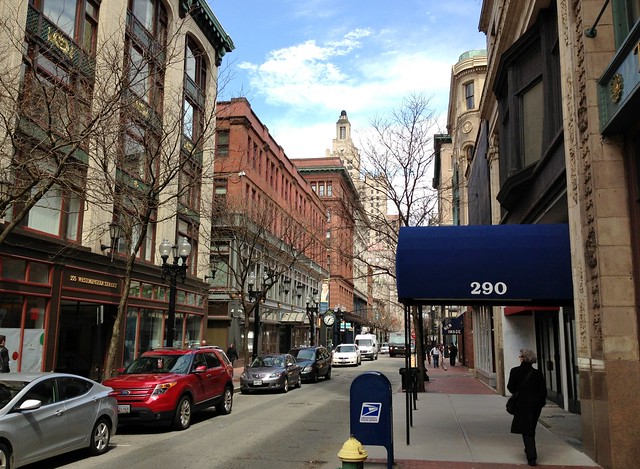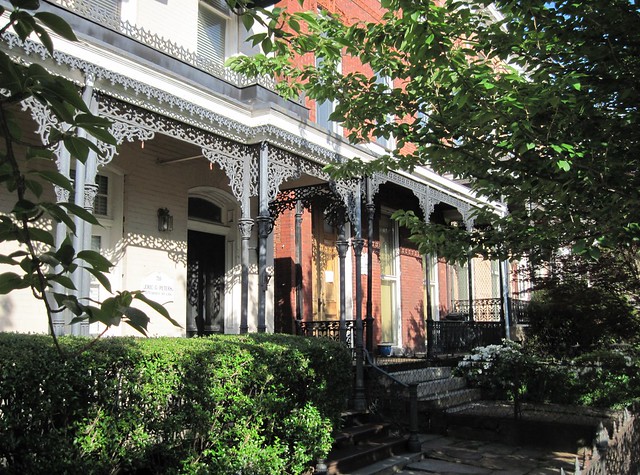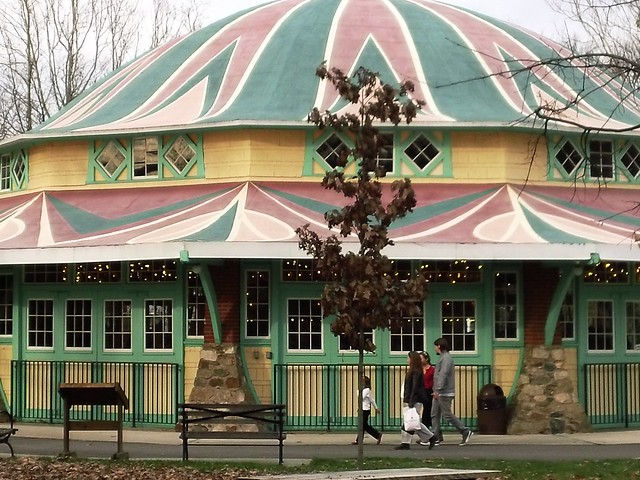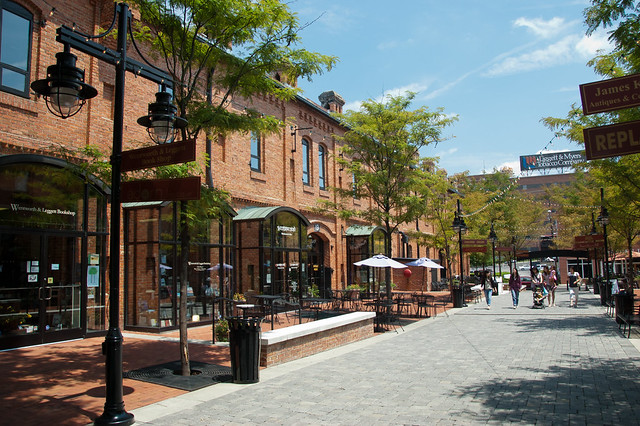Older buildings, continuity of place, and the human experience

Posted May 19, 2014 at 3:15PM
I have been trying trying to understand what makes historic places special to so many of us. Part of it is that they are relatively rare in the United States, I guess. For several decades our newer everyday architecture – our subdivisions, strip malls, office buildings – has been simultaneously bland and deadening in its consistency. Every place looks like every other place, or so it seems. While that isn’t literally true – some exciting buildings are being designed and built, some nourishing new places are being fashioned – the best of our older buildings and neighborhoods have a distinctiveness to them, almost by default.
But I also think there may be something deeper going on. We gravitate to older places because they ground us in space and time. There also is an emerging literature teaching us that they function pretty well, too. I’m not pretending to have all the answers, but here are some concepts that I would like to put on the table for consideration:
Continuity of place
Let me start with a concept that I am calling continuity of place. We’ve all had the experience of being in a setting that has been changed in a major way – by demolition of a group of buildings, perhaps, or by the rise of new ones – since the last time we were there. Sometimes the change can occur in as little as a week. Things seem off, disorienting, anxiety-provoking as we try to get our bearings and tap into our memories of what used to be. When continuity is disrupted, it can be jarring.
Last year Tom Mayes wrote an article for the Preservation Leadership Forum that considers the positive associations we have with continuity:
“[T]he idea of continuity is that, in a world that is constantly changing, old places provide people with a sense of being part of a continuum that is necessary for them to be psychologically and emotionally healthy. This is an idea that people have long recognized as an underlying value of historic preservation, though not often explained. In With Heritage So Rich, the idea of continuity is captured in the phrase ‘sense of orientation,’ the idea that preservation gives ‘a sense of orientation to our society, using structures, and objects of the past to establish values of time and place.’”
Mayes elaborates by citing an essay by internationally known architect Juhani Pallasmaa, who stresses the concept of time in relation to our experience of older places:
“We have a mental need to experience that we are rooted in the continuity of time. We do not only inhabit space, we also dwell in time . . . Buildings and cities are museums of time. They emancipate us from the hurried time of the present, and help us to experience the slow, healing time of the past. Architecture enables us to see and understand the slow processes of history, and to participate in time cycles that surpass the scope of an individual life.”
That rings true for me. There is something comforting about older places.
Research on place attachment and continuity
Indeed, this has been confirmed by international academic research. While examining the topic for this article, I found a paper by Malaysian Professor Norsidah Ujang on “Place Attachment and Continuity of Urban Place Identity.” Ujang contends that uniform concepts of planning and “the commodification of places” – everything looking like everything else – weakens identity and attachment to particular places. After systematically questioning 330 users of three main shopping streets in Kuala Lumpur, the author’s researchers concluded that familiarity with a place contributes to a feeling of psychological comfort, while “psychological discomfort and strong emotional expressions” are “strongly felt as a reaction against physical changes and unfit interventions.”
The paper concludes by recommending that planners take steps to reinforce rather than disrupt place identity and legibility, and strive “to ensure continuity of place identity through proper understanding of places as physical, social and psychological dimensions of human experience.”
Another aspect of our shared architectural legacy that may be important is that it is, in fact, shared. We experience and are comforted by the continuity of older places not just as individuals but as community members. The town square and the court house, perhaps also the old church and the old school – even the Victorian mansions lining a nearby street – bind us together in a way that would be diminished if they were rapidly changing. Their legacy is not just mine but ours.
Cultural engagement
Closely related to continuity of place but also a little different, I think, is something I’ll call cultural engagement. Older places that are unfamiliar, with which we have had no continuity, can also elucidate powerful positive experiences. Think of someone encountering the great pyramids of Giza, or a Native American pueblo for the first time. These places are magical precisely because we have had little or no previous experience, no continuity, with them.
Instead of comforting us with their familiarity, such places challenge our imagination to conjure other times and connect with past cultures in ways that we ordinarily do not. They educate us and equip us with a broader and deeper world view – a view that taps into past wisdom – that we can then bring to more contemporary experience.
I have a favorite, much more modest example that I feature in my new book (People Habitat: 25 Ways to Think About Greener, Healthier Cities). Just a few miles from my house, right across the Maryland border from Washington, DC, sits a partially restored old amusement park dating from the Art Deco era. The old carousel still runs in season and delights kids; you can still buy cotton candy there. But it’s not really an amusement park today – there’s no roller coaster, and the old bumper car pavilion is now an occasionally used music hall. It is certainly unlike any amusement park I ever knew.
Instead, today it exists as a place of respite for adults and of play for kids, and as an evocation of an amusement facility rather than a fully-functioning real one. It challenges visitors to bring our imaginations with us and meet it halfway, as a partial expression of the past and of a culture that no longer exists in the same way. I go to Glen Echo Park often, because it is alongside one of my regular bike training routes, and I love it in a way that I wouldn’t if it were new, even if it were physically the same. It taps into deep cultural connections that wouldn’t be there if I knew the place didn’t have an embodied history to share with its visitors.
Contribution to city vitality
While one of things I like best about Glen Echo Park is that it is relatively quiet (but for the playful chatter of children) and not particularly urban, new research from the National Trust confirms that older, smaller properties in cities make also major contributions to urban vitality.
Based upon statistical analysis of the built fabric of three major American cities, the research (titled Older, Stronger, Better) finds that established neighborhoods with a mix of older, smaller buildings perform better on a range of economic, social, and environmental metrics than do districts with larger, newer structures. The key seems to be the diversity that older, smaller buildings bring to a city neighborhood:
“Buildings of diverse vintage and small scale provide flexible, affordable space for entrepreneurs launching new businesses and serve as attractive settings for new restaurants and locally owned shops. They offer diverse housing choices that attract younger residents and create human-scaled places for walking, shopping, and social interaction.”
In particular, the study – conducted by the Trust’s Preservation Green Lab with several respected partners – relied on spatial analysis to determine the relative role of building age, diversity of age, and size, alongside other measures. More than 40 performance metrics were considered, including cultural vibrancy, real estate performance, transportation options and intensity of human activity.
Compared to districts dominated by larger, newer buildings, those with smaller and older buildings were found to have several key advantages:
- Older districts have more population density and more businesses per commercial square foot.
- Older, smaller buildings support the local economy with more non-chain, locally owned businesses.
- Older business districts offer greater opportunities for entrepreneurship, including women and minority-owned businesses.
- Cultural outlets thrive in older, mixed-use neighborhoods.
- Older, mixed-use neighborhoods have higher Walk Score and Transit Score ratings.
- Older buildings attract more young people and a more diverse age group.
- There is more nightlife on streets with a diverse range of building ages.
Indeed, one might say from these findings that older districts with a diversity of building ages and types are more urban, at least in the traditional sense, than newer, larger building and block types. The methodology appears to have been rigorous and I would encourage interested readers to dive in to the full, 100-page study and its appendices for a more critical review.
Contribution to environmental sustainability
When it comes to sustainability – at least in the literal sense – we don’t need data to demonstrate the performance of older buildings: their continued existence already proves that they have, in fact, been sustained over time. That said, we do have data, at least with respect to environmental sustainability.
In particular, another study by the Preservation Green Lab, released two years ago, concluded that it can take between 10 and 80 years for a new, energy-efficient building to overcome, through more efficient operations, the negative energy and climate change impacts caused in its construction process. The research looked at a range of six building types in each of four climatically diverse cities across the US: Portland (OR), Phoenix, Chicago and Atlanta. Data were compiled and analyzed for six categories of building use (or reuse, in the case of older buildings), including single-family homes; multifamily buildings; commercial office buildings; mixed-use buildings in “urban villages”; elementary schools; and warehouse conversion. The study examined the role that geography, energy performance, electricity-grid mix, building type and building lifespan have on overall environmental performance of new construction versus older building reuse.
The major findings from the study included the following:
- Building reuse typically offers greater near-term environmental savings than demolition and new construction. For five of the six building types considered in the study, it can take 10 to 80 years for a new building that is 30 percent more efficient than an average-performing existing building to overcome the negative climate change impacts related to the construction process.
- Benefits are maximized when building reuse is practiced at scale. For example, retrofitting, rather than demolishing and replacing, just one percent of Portland’s office buildings and single family homes over the next decade would help to meet 15 percent of Multnomah County’s total CO2 reduction targets over the next decade.
- The greatest environmental benefits of reuse are achieved by minimizing the input of new construction materials.
I would add that older buildings, designed and constructed before what my friend and architectural thought leader Steve Mouzon calls “the thermostat age” were often designed with much more attention to climatic conditions than newer buildings tend to be. Through such measures as thick walls, high ceilings, proper ventilation, sensitive shading and site orientation, such older buildings have what Steve calls “original green” properties that help save energy, greenhouse gas emissions, and other resource inputs.
Change, but ask the right questions
In closing, I must add emphatically, though, that all this is not to say that places shouldn’t evolve and change. It would be hypocritical for me as an advocate of revitalization to suggest otherwise. Indeed, we should embrace change that is for the better – change that, as Professor Ujang suggests, does not blur the distinction of place but adds to it. What’s important is that we be thoughtful about it: I’ll admit that it can be tricky to discern in advance which changes to place will be positive and respectful, and which will be negative and disruptive with respect to our experience of place, but good placemakers must always ask the question. And we must always try our best to ensure that change nourishes rather than diminishes the human experience.
Move your cursor over the images for credit information.
F. Kaid Benfield writes about community, development, and the environment on Switchboard and in other national media. Kaid’s latest book is People Habitat: 25 Ways to Think About Greener, Healthier Cities. Today's article was first published in The Huffington Post.
Related posts:
- The very embodiment of sustainability, in a small city (May 9, 2014)
- Why historic post offices matter, and what might help save them (January 22, 2014)
- The case for building on a city's historic assets (April 29, 2013)
- Cincinnati re-opens spectacular park in revitalizing historic district (July 12, 2012)
- When values collide: balancing green technology and historic buildings (June 25, 2012)
- The greenest (historic) building is the one that's in the right context (June 16, 2011)





